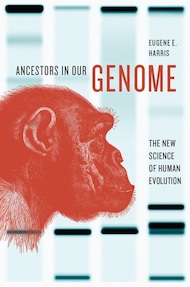Shortlisted for the 2015 ΦBK Science Book Award
By David L. Kirchman
Artistic renditions of our prehistoric relatives are based on often fanciful interpretation of fossils, such as those of a new hominid retrieved recently by spelunkers from a deep cave in South Africa. Eugene Harris, an anthropologist at the City University of New York, shows his fondness of fossils in this fascinating account of human evolution, but his main focus is on another source of evidence about our distant past: the genetic information in our DNA and in our closest living relatives, the great apes, and in the shards of DNA surviving in fossils from our ancestors that went extinct tens of thousands of years ago. His way of sleuthing for clues about our relatives is less dramatic than spelunking for fossils, but it is arguable more informative about where we came from and what defines us as humans.
Harris starts off by looking at orangutans, chimpanzees, and gorillas—candidates for our closest living relative. Based on anatomy, traditionalists in the early 1980s argued that those apes are more closely related to each other than any of them are to humans. A different story emerged from new (at the time) approaches, such as DNA-DNA hybridization, indicating that humans are most closely related to chimps. Then the story was muddled by gene sequence data coming out during the 1990s, with one gene pointing to another great ape, bonobos, as our nearest living “ally,” to use Darwin’s term, while another gene indicated that, no, it’s the gorilla. Using phylogenetic trees and sequences Harris carefully discusses how the different lineages implied by different genes can be used to gleam new information, such as effective population size, about our ancestors. The gene evidence indicates, for example, that the human population was low until it increased dramatically around 11,000 years ago with the advent of agriculture. Harris talks much about how mutations in our DNA escape natural selection because of small population sizes, some leading to diseases or debilitating defects that trouble us to this day.
We now have the complete genomes of humans and of many other great apes. In addition to identifying unequivocally our closest living relative (chimps), the genomic data provide sometimes humbling, always tantalizing insights about our roots. We and other great apes have only about 22,000 genes (potatoes have nearly 40,000), and 20% of human and chimp proteins are identical, while the other 80% differ by only an amino acid or two. Harris speculates about the genes for the brain and speech and other traits that truly set us apart from other apes. But he points out that we need a better understanding of those genes and their regulation before we can say more. And the genetic basis for many traits is complex, to say the least. There are more than twenty genes for the simple (for biologists) trait of skin color.
Harris ends by discussing our relationships with Neanderthals and other archaic hominids, as revealed by sequencing the tiny amount of DNA surviving in eon-old fossils. The genetic data indicate that humans and Neanderthals parted evolutionary ways between 270,000 and 440,000 years ago, and then met again in southern Europe after humans left Africa about 50,000 years ago. There is speculation that humans drove Neanderthals extinct, but there is also evidence in our genomes of more friendly encounters. We have some DNA from Neanderthals and other archaic hominids, although the amount is small, indicating little interbreeding according to Harris. Less salacious but more telling, the varying numbers of archaic hominid genes in humans around the world today mark the routes by which we migrated out of Africa and colonized Eurasia and beyond.
Harris gives us glimpses of the science behind these amazing discoveries of our ancestors. He explains the basics for non-biologists before diving deep into human genomics and population genetics. He unobtrusively notes his involvement in the work.The writing is always clean and light in spite of the tough concepts and jargon. The result is an incredible story of what genes and genomes can tell us about our distant past and our current condition.
David L. Kirchman (ΦBK, Lawrence University, 1976) is the Maxwell P. and Mildred H. Harrington Professor Marine Biosciences at the University of Delaware and a resident member of the Alpha of Delaware chapter of Phi Beta Kappa.




